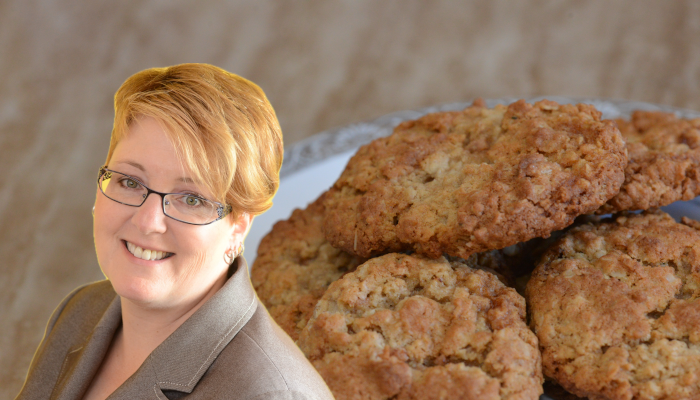Mary Cojocar was a good cook and it was a pleasure to be a guest at her house during holidays or any event. Cabbage rolls were always served. Here we have her preferred recipe.

Mary Cojocar nee Banda was the first daughter born to Vasile & Mary during the Saskatchewan winter of 1916. She was one of eleven children, nine of which survived to adulthood. Her childhood homelife was challenging as her father died when she was eleven years old and then her step father passed away suddenly when she was fifteen. As the oldest daughter she and her siblings assumed many housekeeping and farm duties to keep the family farm running without a father. Mary worked as a servant for an English couple farming nearby to reduce the burden on her mother. Just before her eighteenth birthday was married George Cojocar. Even as a young bride she was fully capable of running a household and certainly had a list of well practiced recipes at her command when she began her married life.
The best cabbage rolls
If you are descended from one of the cabbage roll making cultures you likely have some strong opinions about the dish. Each region seems to have some variations on ingredients and then within individual households there are preferred recipes. Feelings run strong and everyone believes that their cabbage rolls are the best. So in that vein, these are Mary’s cabbage rolls and they are the best.
Sour cabbage
This recipe asks you to start with a fresh cabbage rather than using a sour cabbage. Sour cabbage is a cabbage head that has been fermented in salt water. It is basically sauerkraut made as a whole head of cabbage. Some people like to make their cabbage rolls using sour cabbage.
Personally I don’t prefer cabbage rolls made with sour cabbage. I am told that beyond the flavour the sour cabbage imparts, the pickling of the cabbage gives a strength to the leaves and this makes the rolling easier and allows the rolls to be made tighter.
Summer Cabbage
When my wife joined the family Mary brought her in to the kitchen to learn how to make cabbage rolls. Mary explained to her that the selection of the cabbage was very important. You want to choose a cabbage that has the smooth type of leaf, not a crinkly one like you find with a savoy cabbage. The cabbage should not be so large that the large vein on the back of each leaf is huge and woody. The cabbage should be of a size where you will get a fair number of good sized leaves before you get deep inside the cabbage to the small leaves which may be too small to roll well.
Mary’s final advice was to choose “summer cabbage”. By this she meant that fresh cabbage leaves had the best texture. Cabbages you are buying in the winter are possibly weeks or months old and the texture of the leaves has changed. Her recommendation was to either make cabbage rolls in the summer and freeze them to serve in the winter or to blanch and freeze summer cabbage leaves for use in the winter.
Ingredients
- 1 Medium head of cabbage
- 1lb lean ground pork
- 3 Medium onions (minced)
- 3/4 cup Long grain rice
- 2.5 cups Tomato juice
- 1 – 284ml Can Campbell’s Tomato Soup
- 1 tbsp Ketchup
- 1 tbsp Salt
- Some black pepper (to taste)
- Some paprika
- Water
Preparation

Depending on how proficient you are at making cabbage rolls the preparation time before you begin cooking them could be a couple of hours. Cook time is a further 1.5 to 2 hours. In my experience cabbage rolls that have cooked and are reheated the next day taste the best.
In a large mixing bowl combine:
- 500g Lean ground pork
- 3 Medium onions (minced)
- 3/4 cup Long grain rice
- 1 284ml Can Campbell’s Tomato Soup
- 1 tbsp Ketchup
- 1 tbsp Salt
- Some black pepper (to taste)
- Some paprika
With a paring knife cut around the core of the cabbage deep into the centre of the cabbage so that the core can be removed. You are cutting all of the leaves free of the cabbage stem.
Place the cabbage with core removed in a large empty pot that has a lid which will cover the cabbage. Fill the pot about 1/3 full with water. Bring the water to a boil then cover the pot and simmer.
As the cabbage steams the leaves on the outside will cook first. As the outer leaves soften and loosen, gently peel them from the cabbage with a fork and remove them from the pot. Stack them on a plate to cool. Repeat until all usable leaves have been collected.
The pot that you cook the cabbage rolls in must have a lid. Line the bottom of the pot with a couple of cabbage leaves, possibly the smallest ones from the centre of the cabbage. This is to prevent sticking or scorching.
Look through the cabbage leaves you have steamed and see if any of the veins on the back of the leaves need to be shaved flat to the surface of the leaves. Take a knife and shave any flat if you think they are took thick. If you think that any of the leaves are big enough to make two or more cabbage rolls cut them to size.
Filling the cabbage rolls

There are two shapes that rolls are made into; a cylinder or a cone. In either case the cabbage must completely encase the filling. Once cooked, a cabbage roll should be able to be lifted out of the pot without a risk of it falling apart or having leaked it’s filling into the pot during cooking.
Place an amount of filling into each leaf and roll into your chosen shape.
As you put the cabbage rolls into the pot leave some gaps between them so that water and juice can circulate. As the rice in the filling will also expand during cooking you want to leave a little space for this too.
When you have finished creating all of the cabbage rolls pour in the Tomato Juice and add water to cover the cabbage rolls.
Cooking
Bring the cabbage rolls to a quick boil then cover with a lid and simmer for 1.5 to 2 hours. Remember that you are trying to cook the rice so try not to peek very often and, if necessary, add a little water.
It is VERY important that the lid on your pot seals well!! The pressure inside of the pot is what will force the water inside of the rice grains and cook them through.




